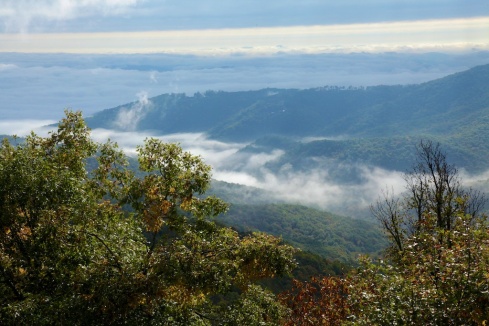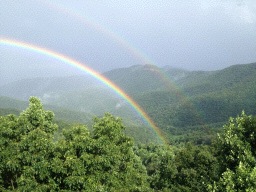
Recently, in the midst of teaching a Silent Retreat at our Art of Living Retreat Center I was interviewed by Andrew Keaveney on the Art of Silence and the value of places like the Boone Center… below are some excerpts…
Looking over this blog I see that I haven’t added to it in over two years! In preparation for a book that I’m in the midst of, I promise to contribute in a more regular fashion:)
Some of the courses that I enjoy teaching the most in the Art of Living are our residential silence courses. People come on the course from a world of noise. Except for maybe brief periods of meditation (and sleep!) most people rarely get to experience silence. Especially here in Boone, there is a great opportunity for interior silence because there is already a strong foundation or environment of exterior silence here in the mountains. Right from the first day of the course I see people start to settle down as soon as they go into silence and they begin to experience themselves at a deeper level.
Q: What is the value of silence?
John: There is a wonderful quote from the early Christian church that says there is only one great teacher of prayer and meditation and that’s the Holy Spirit and the only language that the Holy Spirit speaks is the language of silence. So there is a lot that happens on these silence courses; it’s a kind of knowledge and connection transmitted without words and it’s extremely valuable. People discover things about themselves, about their relationship to other people, about their relationship to the universe and it’s a really rewarding thing to be able to assist people in that process. Silence also gives our participants a deep rest on many levels…a physical rest of course, but also a rest from the thousands of small distractions which most of us have to deal with every day. The mind takes a deep dive and discovers its infinite source in that silence.

Q: Why does that happen in silence, be able to discover more about themselves, rediscover their relationship to other people, and their connection to the universe?
John: Because in our day and age the stimulus from outside is so great and unrelenting. The internet, cell phones, a twenty-four hour news cycle, the kind of activities people jam into their day when they are always with their family or they are working long hours or whatever, pull them constantly outward away from their source. Even when they are in their car they are usually listening to the radio or they are sending or receiving something on their cell phone. The outside stimulus especially now in the modern world is so great that even if there was some silence happening on an interior level, the senses are moving outward all the time and people won’t be able to easily experience it. This is the first time for a lot of people to be able to experience deep silence within themselves and it’s like a tonic, you see them resting better, you see them feeling more contentment; a smile may actually appear on their face. It’s a wonderful transformation that happens. I think it’s a healthy and essential experience for any human being to have and this environment on the top of this mountain is ideal for it because the outer atmosphere is so silent, so pristine and so full of the experience of Nature, and also all the necessary tools are already in place here: yoga instruction , meditation techniques, breath work, certain kinds of sound therapy and music to assist in people being able to experience a deep level of silence right away, a holistic spa and health center to help balance and rejuvenate the body. Many of my students have told me that they experience an enormous increase in energy in just 3 or 4 days so that they leave really refreshed, renewed and quite often very transformed.
Q: Can you tell us a little about the history of silence? Is this thing new that people are just now doing?
John: I think people lived in earlier times largely in silence. Before electricity, before radio, before television, people went to bed when the sun went down and they got up when the sun came up and there was lots of silence especially in agrarian societies. I worked on a ranch in Colorado earlier in my life and I spent 8-10 hours by myself outdoors largely in silence. I was working as a ranch hand and I think that type of experience was normal for most people, that kind of life, in earlier times, but then the industrial revolution and electricity and radio and television came along and with people moving into cities, that aspect of silence was lost. But in both the east and in the west, within these ancient spiritual traditions silence was highly valued and people gravitated to live near ashrams, spiritual communities and monasteries. In Europe for that very reason, a thousand years ago, whole cities sprang up around monasteries because the monks kept silence and the ordinary people honored that value of silence a lot. Similarly in Asia, in the villages especially, even now people still very much value the wandering monk or the sadhu or the Buddhist that comes and begs at their door because they are holding that value of silence not just for themselves but for the whole society. It’s a very important experience to have available to us, one that is increasingly rare and that’s one of the greatest values of this place not only for people who come here but for the whole society…. It’s extremely important that there are places set aside that people can still experience that. That experience anchors and reaffirms one’s very humanity and it strengthens the human values in society as a whole.

Q: How does this place help support that? What do you appreciate about it?
John: This place was designed right from the beginning, to nourish in a deliberate way the experience of silence and meditation. Architecturally the way the buildings are designed, the way the courses are structured, the way the food is prepared, all of that is with one end in mind; to bring people closer to that deeper part of themselves. So when you come here everything is all set up, the rooms are in place, the food is conducive to being in silence, the courses are already designed and set up at various levels, introductory or advanced, for people to just step in and even if they have only 3 or 4 days, almost immediately they drop in and begin to experience that deep value in themselves and then they carry it with them back out into the world.
Every year more people are discovering this place, and there is a reason for that. Retreat centers, monasteries, places where people can go for silence are becoming increasingly popular because as the world grows smaller and things are moving faster, there are a lot of challenges that are coming up for people. Terrorism, environmental degradation, natural disasters and all kinds of accelerating changes confront people and they need the resources deep inside to be able to deal with these and they don’t find them often in their everyday life. This experience is kind of an antidote to all that noise, to all that change so that people can not only connect deeply inside themselves to something which is unchanging, but in those deep places they can begin to find solutions to a lot of their challenges in life and can also begin to contribute to solutions to some of the world’s larger problems. So,this community, this mountain top is a kind of a fertilizer or an energy source not just for the people who come here but potentially for the whole world.

2 comments
Comments feed for this article
October 29, 2016 at 1:04 am
On Silence — Avahanam | Avahanam
[…] via On Silence — Avahanam […]
October 29, 2016 at 2:30 am
yogafarmlansing
Thank you John ❤